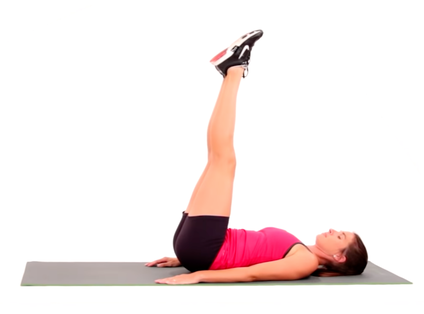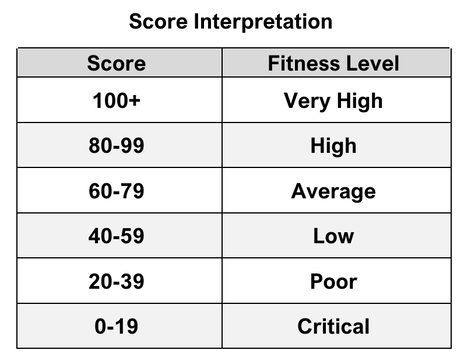Med-Fit Tech Assistant
Medical-Fitness Assessment - Learning Module #8
Muscle Fitness
Part B
Part B: Core Muscle Fitness
Learning Objective:
Learning Objective:
- Properly conduct the Leg-Raise Test
- Calculate the Core Fitness Score
The Leg-Raise Test for Core Muscle Fitness is a 2-minute AMRAP (as many reps as possible) during which the participant tries to perform as many lying leg-raises as possible (to the best of his/her ability) until the time runs out.
The lying leg-raise is a core exercise that mainly targets the Rectus Abdominus and Psoas muscles.
The lying leg-raise is a core exercise that mainly targets the Rectus Abdominus and Psoas muscles.
Know how to do a Leg-Raise.
(Tap/Click the photo to watch the video on Youtube.)
(Tap/Click the photo to watch the video on Youtube.)
Lying Leg-Raise Instructions:
- Sit on the floor with your legs together and straight
- Place your hands behind your hips
- Lay back into the supine position
- Your hands may be either flat under the hips or to the side, whichever is more comfortable.
- Start be hovering your feet just above the floor
- Lift your legs by flexing your thighs while keeping your legs straight
- Stop flexing your thighs when your legs are straight up, perpendicular to the floor
- Slowly lower your legs to hover your feet just above the floor
Test Instructions:
- Make sure the participant has a full-length mat and plenty of space.
- Demonstrate how to perform a leg-raise by doing several reps, but pausing to explain the body movement.
- Have the participant perform a leg-raise to the best of his/her ability.
- The participant should raise his/her legs only as high as it is comfortable for them and still be able to lower their legs in a controlled manner.
- Explain that they should try to not touch the floor with their feet, but to get as close as possible.
- Explain that if they do touch the floor or if they do not get "close enough" to the floor that they should continue with the next rep.
- Explain that they can stop and rest if needed, but if they do, the clock keeps running.
- Let the participant practice a few leg-raises as a warm-up.
- Explain that you will start the clock when he/she is ready to start the test.
Test Protocol:
- Stand or sit several feet away from the participant so that you can observe the complete leg-raise movement.
- Confirm that the participant understands the leg-raise movement and the test procedure.
- After the participant has warmed up, ask him/her to indicate when he/she is ready to begin.
- Start a hand-held 2-minute timer when the participant begins doing his/her first leg-raise.
- Count out loud each completed leg-raise at the feet-hovering position.
- Observe the participant at all times and check their body movements.
- Especially note the degree of flexion of their thighs and extension of their legs.
- Also note the consistency of their feet getting to the low hovering position at the end of each rep.
- Do not inform the participant how much time is remaining on the clock.
- At the end of the last leg-raise at the 2-minute mark, say out loud: "Stop."
- Record the total number of completed leg-raises during the 2-minute test.
Scoring the Test Result:
- Divide the total number of Leg-Raises by 60 and then multiply that number by 100.
- Round off to the nearest 0.1 decimal point.
- Example: Total Reps = 43 leg-raises. (43 / 60) x 100 = 71.7 (Raw Rep Score)
- Grade the participants ability to perform the standard leg-raise:
- -- A = Consistently raised their straight legs to the perpendicular (90-degree or more) position and returned their feet to hover just above the floor.
- -- B = More consistently raised their almost straight legs to the near perpendicular (less than 90-degree) position and usually returned their feet to hover fairly close to or lightly touch the floor.
- -- C = More consistently raised their almost straight legs to the 60-degree or more position and returned their feet to hover well above or touching the floor.
- -- D = More consistently raised their significantly bent legs to the less than 60-degree position and returned their feet to hover well above or touching the floor.
- Adjust the participant's Raw Rep Score by their Grade to get their Core Fitness Score:
- -- A: Raw Rep Score = Core Fitness Score (no grade adjustment)
- -- B: Raw Rep Score - 10% = Core Fitness Score
- -- C: Raw Rep Score - 25% = Core Fitness Score
- -- D: Raw Rep Score - 50% = Core Fitness Score
- Example: 71.7 Raw Rep Score with a B Grade = 71.1 - 10% (71.7 x 0.10 = 7.17) = 71.7 - 7.2 = 64.5 Core Fitness Score
Core Fitness Score Interpretation:
- A Core Fitness Score of 100 (or more) indicates a Very High Fitness Level
- Scores above 100 are admirable, but they do not necessarily confer a health or longevity benefit.
- Since the fitness test is sub-maximal, scores above 120 are not necessarily comparable.
- A Core Fitness Score below 100 indicates "room for improvement," depending on the age of the participant.
Note: An “average” fitness level among an unfit and unhealthy population that is at increased risk for sedentary-related chronic disease resulting in premature disability and death is not satisfactory.

